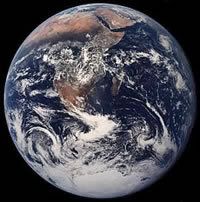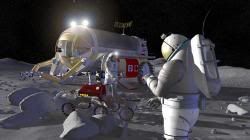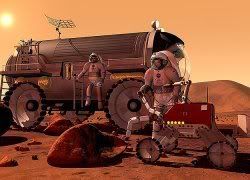Dear NASA, Its Luna Or Nothing! (And That Includes Mars Too!)
For those of you who are unable to spend half their lives in the blogosphere (or on Twitter), you might have come across the frenzied response to NASA's acting administrator's suggestion that the US should skip a lunar base and instead focus on the red planet and a few space rocks dancing around Sun.
While I am all for imprinting human footprints, holes, and tire marks in other worlds (and dwarf worlds--sorry Pluto), simply bypassing a permanent residence on Luna for Martian glory is the fastest way to kill America's future in space, if not set us back a few more decades.
For those of you wondering why a moon base matters, here are five (5) reasons why NASA needs a lunar settlement on Earth's nearest neighbor.
Its the gravity, stupid!
If humans are ever going to settle the heavenly worlds that dot our sky, then we need to find out whether our bodies are suitable to survive long term off world. Since there are currently 83 terrestrial worlds with gravity ranging from 1/2% to 91% Earth norm, finding the bare minimum will be critical, as it will determine which worlds humanity can raise families upon.
Since the Moon's gravity is approximately 16.6% Earth norm, it is a perfect candidate for seeing how well our carbon vessels handle a lighter pull from below. Since many of the larger moon worlds (like Ganymede, Callisto and Titan) have similar gravitational strengths, our fair lady Luna may enlighten us as to whether humans will settle beyond the inner belt, or simply upon two worlds (the latter being Mars).
Gravity Well Hell
Lets face it, space is expensive. Unless someone can find a way to build a space elevator (or even a Skyhook), launching anything "into the black" is probably going to be somewhat pricey, regardless of which planet, moon or dwarf planet you choose.
Although worlds like Mars and Mercury have a stronger gravitational pull (both a little south of 38% Earth norm), they also have deeper gravity wells, making fiery exits a bit more expensive.
Worse, NASA still has yet to figure out a way to land large payloads upon Mars, which is not good coming from an agency with the best record for red planet encounters.
Even though the Moon and Mars have different environments (the glorious vacuum verses the 1% atmosphere) it may be wise to heavily test our landing capabilities on Luna (perhaps even "overloading" a lunar lander to help simulate a Martian landing).
Drill, Baby Drill!
Unfortunately for our species, most worlds in our star system are not blessed with a decent atmosphere, which means drilling through dust, rock and metal is not going to be fun, especially when those regolith fragments fuse to your drill bit).
Finding out how to do this effectively will be critical if we are to ever mine the asteroid belt--not to mention settle upon the various moons within our star system. Learning this lunar lesson could prove to be invaluable later on, and could equip our rowdy species with the knowledge to harvest the solar system, (instead of merely dwelling upon worlds for the view).
Dude, where's my spleen?
Although the above sub title may sound like a sick statement (no pun intended), the fact of the matter is that medical emergencies will probably arise off world--even if ones sole purpose is to merely visit (and not inhabit).
With the Moon being only three (3) days journey away via rocket ride, it is far enough away to test a space facility's independence--yet close enough just in case we need to intervene in an emergency beyond a space base's expertise.
Perfecting this will be critical if humanity is to establish outposts elsewhere, as the last thing NASA (or any space agency) needs is dead bodies accumulating due to the lack of treatable wounds, diseases or outbreaks.
Seeing is believing
Space, like all things glamorous will tend to fade from public glory as humanity begins to travel deeper "into the black." Unless NASA desires to repeat the effects of Apollo, they will need to find some way of keeping our emotions focused on the stars outside of a tragedy.
While rovers driving upon extraterrestrial soil will spark some interest into space exploration, the public at large will probably ignore such accomplishments due to the fact that its made of silicon instead of flesh and blood.
Although seeing a human visit the Moon would accomplish the same result as an off world rover, observing someone live upon the Moon could help spark more people to realize that their destinies belong to the stars.
A long term settlement could also serve as a counterweight, making it much more difficult to abandon the final frontier in the face of future recessions or tragedies beyond Earth's orbit.
Conclusion
While the Moon is a critical first step for NASA--or any aspiring space power--it should not be the last in our attempts to embrace the heavens above us.
Even though the Moon will not be the perfect beta test for every world that is graced by Sol star's rays, establishing a presence there will help us settle else where, as well as increase our chances of avoiding asteroid doom (or the various other ways of mass extermination of humanity).
Hopefully President Obama, as well as the new NASA administrator realizes this, as the last thing we need is another space race where the US is playing catch up to a (semi-hostile) rival.
Carnival Of The Space Geeks (The Lunar Edition)
Whether you are made out of carbon or silicon, I would like to welcome you to the 89th Carnival of Space, hosted by the Moon Society, an organization dedicated to motivating the masses to reclaim our lunar heritage (which was laid down by our forefathers many moons ago--pun intended).
For the multimedia inclined, be sure to check out "a few" of our videos, as well as Lunarpedia (our wiki).
Now without further delay, here is the 89th Carnival of Space! (which will kick off with entries regarding our current terrestrial home, Earth)

From the Homeworld
Wayne Hall of Kentucky Space predicts that by 2020 every company will be asking "What's our space strategy?," while Brian Wang of Next Big Future dreams about Skylon Space Planes (can you say SSTO!).
Meanwhile the mysterious DJ (from Orbital Hub) discusses gravity mapping with NASA's GRACE, while those of you addicted to "all things Twitter" will enjoy an entry by Robert Simpson (from Orbital Frog) regarding celestial (and terrestrial) objects flying over your city.
Ian Musgrave (from Astroblog) enlightens everyone on how to properly convert the "terrestrial masses" via radio interviews while NASA Education introduces a few Do-It-Yourself podcast tools which may aid teachers attempting to create space disciples (hat tip: David Bigwood).

Our Fair Lady Luna
Do you remember everyone's favorite beagle Snoopy? Well, apparently Snoopy and his owner Charlie Brown have some lunar history beyond the cartoon, which CollectSpace highlights.
Speaking of history, Dr. Bruce Cordell from 21st Century Waves discusses whether our landing lunarside was a random fluke or destiny while Mark Whittington wonders why President Obama chose to read The Moon Over Star to 2nd graders, and whether it reveals his vision for NASA.

The Red Planet (and his side kick Pluto?)
Often seen as the red home of humanity, Mars is one planet that seems to excite the masses. Fortunately we have the technology to observe our crimson neighbor up close, as Emily Lakdawalla (of the Planetary Society) publishes a gorgeous image, courtesy of Hubble.
For some though, seeing images is never enough, which is why Ryan Anderson (from Martian Chronicles) is proposing that we voluntarily exile willing subjects to the Martian surface instead.
While Mars does lack beach front property that one would find on Earth, it does however boast some interesting features ranging from depressions (which Phil Plait of Bad Astronomy fame enlightens us about) as well as fresh craters which Stuart Atkinson (of Cumbrian Sky) blogs about.
Although Mars is arguably understood by all to be a planet, Pluto seems to have been left out of this exclusive club, which is why Bruce Irving from Music of the Spheres is calling for Pluto to be recognized as a planet (as dwarf planets are planets too--just smaller).
The Celestial And Extraterrestrial (planetwise that is)
Moving on towards deeper space (and darker objects), Kimberly Arcand (of Chandra Blog) posts a fascinating image of a gluttonous black hole. Speaking of black holes, Carolyn Petersen (from the Space Writer) explains how these monsters are formed (which are often at the center of beautiful galaxies such as these).
If anyone has ever wondered why nebula's are sometimes (unfortunately) called Planetary nebula's, Mike Simonsen from Simostronomy will gladly enlighten you.
Those of you seeking out rocky bodies beyond are star system will be delighted to hear that we have spotted yet another exo-planet which Paul Anderson (from Merid iani Journal) notes is twice the size of Earth!
Unfortunately as Dave Mosher from the Space Disco informs everyone, this planet is probably not habitable as its orbit is just a "little too close" to its parent star.

Questions Without Answers (unless you're an alien)
Does humanity hold a special place in the Universe? That's a question that Ethan Siegel (from Starts With A Bang!) is attempting to answer.
Meanwhile Ian O'Neill of AstoEngine explains why any aliens "next door" may not be able to hear us, while Paul Gilster from Centauri Dreams re-examines the Drake Equation (which could explain why we have not found anybody nearby).
Nicole Gugliucci from One Astronomer's Noise blogs about her adventures at SETI while Timothy Neale of Tomorrow Is Here asks the ultimate cosmic question: what was that noise?
__________________
Thanks for visiting the 89th Carnival of Space, and for those of you seeking to publish your thoughts upon the next round, feel free to visit Universe Today for details on how to enter.
Did Somebody Say Moon Quakes?

First there were earthquakes. Then there were sunquakes. Now it seems as if Earth's little sister may have caught "the shakes" which could threaten future lunar settlements.
(NASA) There are at least four different kinds of moonquakes: (1) deep moonquakes about 700 km below the surface, probably caused by tides; (2) vibrations from the impact of meteorites; (3) thermal quakes caused by the expansion of the frigid crust when first illuminated by the morning sun after two weeks of deep-freeze lunar night; and (4) shallow moonquakes only 20 or 30 kilometers below the surface.
The first three were generally mild and harmless. Shallow moonquakes on the other hand were doozies. Between 1972 and 1977, the Apollo seismic network saw twenty-eight of them; a few "registered up to 5.5 on the Richter scale," says Neal. A magnitude 5 quake on Earth is energetic enough to move heavy furniture and crack plaster.
Furthermore, shallow moonquakes lasted a remarkably long time. Once they got going, all continued more than 10 minutes. "The moon was ringing like a bell," Neal says.
According to NASA, because the Moon (aka Luna) lacks water and an atmosphere to soften the ground below, whenever a lunar quake occurs the whole ground just keeps "vibrating like a tuning fork."
While more data is needed whether to determine how often (and exactly where) do luner quakes occur upon Earth's nearest neighbor, and future settlement established there will probably have to design very flexible outposts (in order to prevent life threatening cracks from appearing in the walls).
Keeping Your Moon Base Dust Free (Without Hiring Martha Stewart)

Despite its beautiful, "crispy" appearance, lunar dust can be a nuisance to both man and machine, clogging gears and irritating lungs.
Now it looks as if scientists have developed an innovative way of removing these pesky particles without the need of hiring a professional lunar duster.
(New Scientist) To solve the problem, Clark's team is working on SPARCLE, a "lunar dust buster" that astronauts could utilise in the airlock to a moon base. The device consists of a positively charged metallic nozzle fitted to an electron gun, similar to those used in electron microscopes, which fires a focused beam of electrons from a hot filament.
Following a moonwalk, astronauts would scan the beam across the surface of their dirty equipment, showering it with electrons until all the dust particles and the surface become negatively charged and start to repel one another. This would loosen the particles' grip, allowing them to fly to the positively charged nozzle where they are captured.
While this technology will obviously benefit astronauts fortunate enough to explore Earth's nearest neighbor, it will also help reduce "lunar chores" around a future space base (as our astronauts would probably rather work at the lab than dust it off).
(Hat Tip: Space Transport News)
Calling alll Bloggers!
Link: http://www.moonsociety.org/volunteer-descriptions.html#bloggers
At the January 21st Management Council meeting, it was decided to do something with our blog. This blog was created to handle daily news from our simulation crew at the Mars Desert Research Station, Feb 26-Mar 11, 2006.
After the simulation was over, I tried to keep it going and for a time I was posting 2-5 times a month. Even that pace is insufficient to keep blog watchers interested.
In between there has, I believe, been one post by Charles Radley and another by James Rogers.
We are now actively looking for more bloggers.
The Planetary Society has an excellent blogger, Emilly Lakdawalla. Not sure if she is a paid volunteer or a staff person, but she keeps it going.
http://planetary.org/blog/
Now NSS has just announced its new blog
http://blog.nss.org
Not sure who is behind that as I just heard about it today in the new NSS Downlink e-letter
Take a look at all the long list of categories listed on the NSS blog page
These suggest a divide and conquer approach. I would be happy to come up with an appropriate list of appropriate categories.
For example, we might get Ken Murphy to post on new books
Someone else on NASA
Someone else on Private Enterprise
You get the idea.
I think this approach has real possibilities.
We could even solicit posts from our chapter leaders, as they will have an "on the ground" approach that may be refreshing.
Our various Project Team leaders (we have ten teams) could post progress updates
I suggest that we work a feed from the NSS blog now that we are mutually affiliated.
Who sees the blog? That was the question to date.
But we are talking about moving the feed for the daily news stories to another page, just keeping the link on the home page, and using that large vacated space for the current blog post.
So how about it?
Email me if you are interested.
kokhmmm at aol.com
Tell me about your blogging experience and about your favorite Moon-related and space-related topics.
Peter Kokh
President, The Moon Society

 05/07/09 02:56:02 am,
05/07/09 02:56:02 am, 